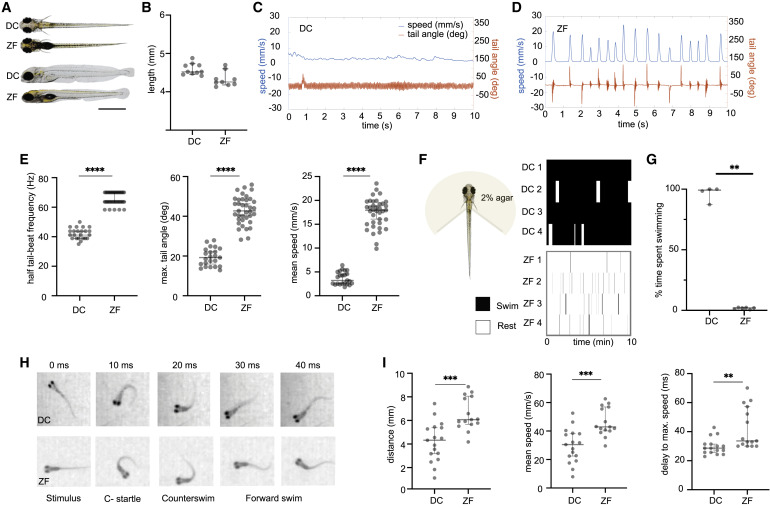Fig. 1
Figure 1. Kinematics of spontaneous swimming, head-embedded swimming, and escape response in DC and ZF Larval DC and ZF measure similar in size at 5 dpf. (A) A dorsal and lateral view of DC and ZF at 5 dpf is shown. (B) Measurement of body length in 5 dpf DC and ZF falls in a range of 4.1–4.9 mm. N = 10 DC; N = 9 ZF. (C and D) A comparison of swimming patterns in 6 dpf DC and ZF. It demonstrates the continuous swimming pattern in DC with lower speed (cyan) and smaller tail angle (orange) when compared with the faster discrete swimming in ZF. (E) Swimming kinematics of DC and ZF in a spontaneous swimming assay. DC utilizes lower half tail beat frequency (Hz) and lower maximum tail angles (degrees) to achieve swimming at lower speeds (mm/s) when compared with ZF (N = 23 DC, n = 494,628 half tail beats and N = 37 ZF, n = 202,176 half tail beats). (F) Tail movements in head-embedded preparations depicted in raster plots illustrate the prolonged swims of DC (top) compared with the short bouts of ZF (bottom). (G) The fraction of time spent actively swimming (percent of total acquisition time) is higher in DC compared with ZF (N = 5 DC and N = 6 ZF). (H) Qualitatively, the escape response after a tap stimulus is highly similar between DC and ZF. The images were acquired at 100 Hz. (I) Although DC covers a shorter distance at a lower mean speed, the time to achieve the maximum speed is lower in DC compared with ZF (DC, N = 19 fish, n = 141 events; ZF, N = 15 fish, n = 159 events). ∗∗p < 0.01, ∗∗∗p = 0.001, ∗∗∗∗p < 0.0001; Mann-Whitney test. All error bars show 95% confidence interval. See also Figure S1.
Image
Figure Caption
Acknowledgments
This image is the copyrighted work of the attributed author or publisher, and
ZFIN has permission only to display this image to its users.
Additional permissions should be obtained from the applicable author or publisher of the image.
Full text @ Cell Rep.

